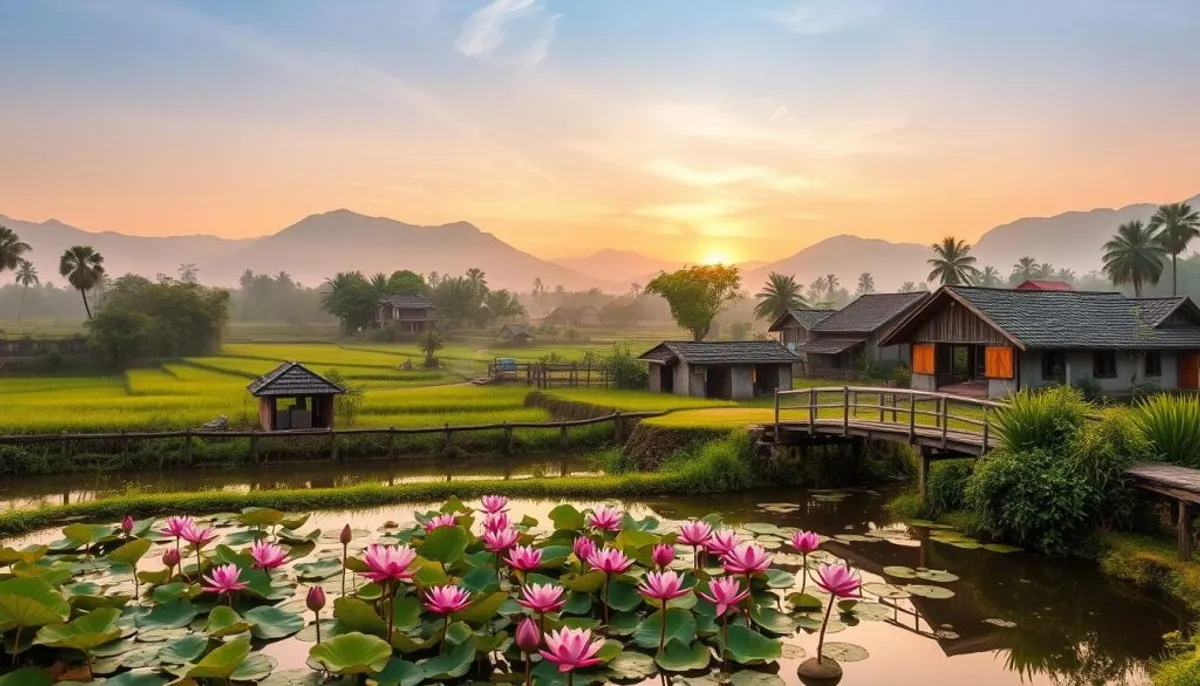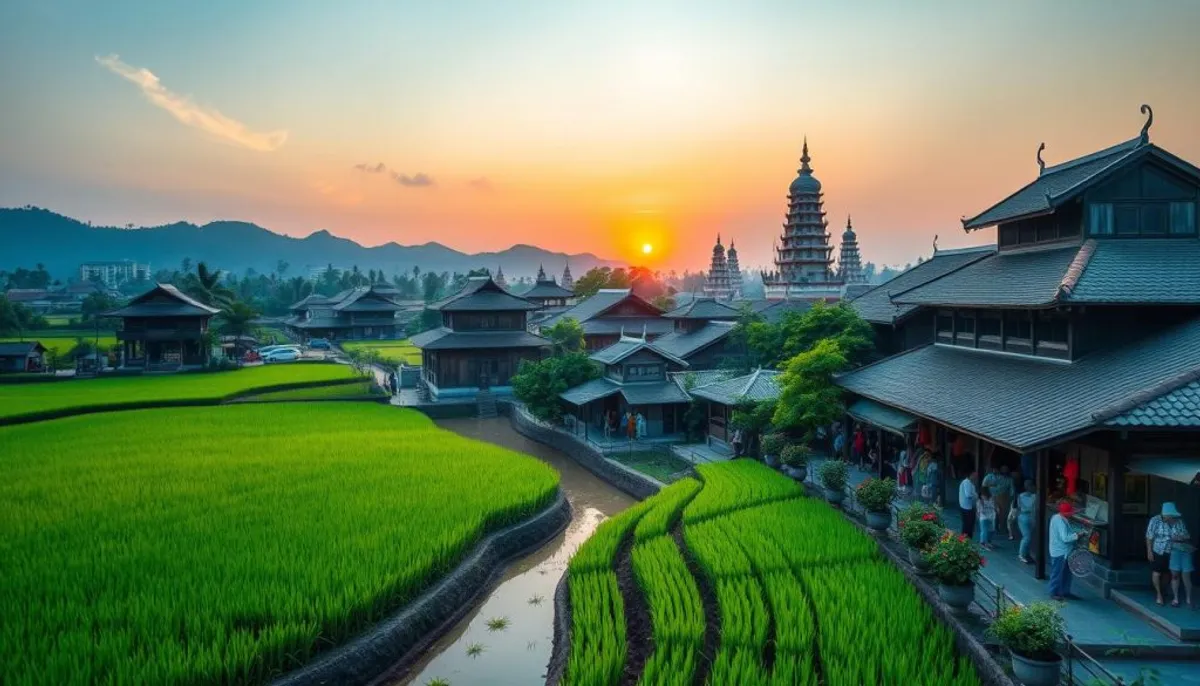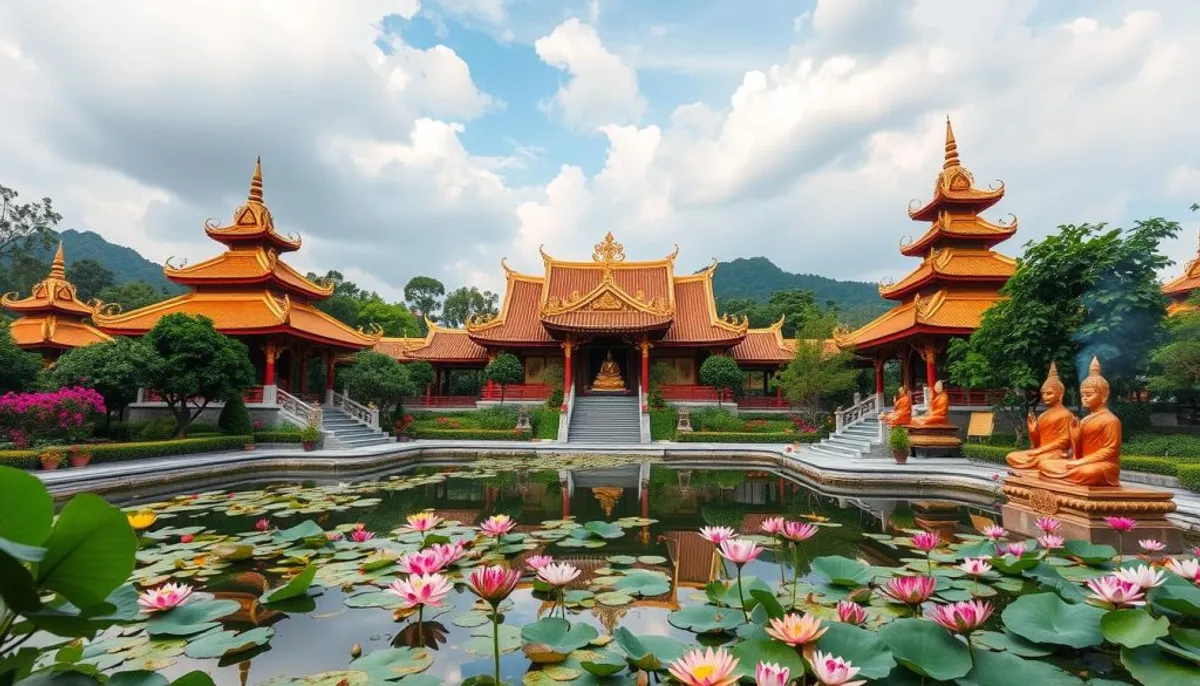Vietnam stands out for its rich and varied heritage. Located in Southeast Asia, it showcases an impressive cultural diversity. From the mountains to the delta, ancestral traditions are maintained and evolve.
The Vietnamese society is a unique blend. It is home to around fifty ethnic communities, each enriching the country's culture. The Viets, Khmers, Han Chinese, and other groups live together, preserving their languages and traditions.

History has shaped Vietnamese identity. Chinese influences are evident in philosophy and the arts. The colonial French heritage has marked architecture and religion. The country is dominated by Buddhism, but Catholicism is also present.
Colorful festivals enliven life in Vietnam. Tết, the lunar new year, is a joyful celebration. The Mid-Autumn Festival, with its mooncakes, enchants all ages. These celebrations reflect the richness of local traditions.
Vietnamese craftsmanship is a testament to ancestral know-how. Van Phuc silk, lacquer art, and water puppetry are cultural treasures. These practices, passed down from generation to generation, are essential to Vietnamese identity.
What is Vietnamese culture: a millennial heritage
Vietnamese culture, rooted in the country's millennial history, is a true treasure. It reflects a rich past, influenced by various civilizations and a complex history. The Chinese occupation, for example, left a lasting imprint on Vietnamese culture.

Historical and cultural influences
The history of Vietnam is a complex tapestry of influences. Ten centuries of Chinese occupation have profoundly marked the country. This is evident in the fact that 60% to 70% of Vietnamese words derive from Chinese. The Nguyen dynasty unified the country in the 19th century, just before the arrival of the French. These periods contributed to shaping Vietnam's unique cultural identity.
The ethnic diversity of Vietnam
Vietnam is a mosaic of ethnicities. Although 86% of the population is Viet, the country is home to around fifty ethnic communities. Each brings its own language, traditions, and heritage, enriching the cultural fabric of the country.
The importance of traditional values
Cultural values are central to Vietnamese society. The extended family is the foundation of culture, extending beyond the immediate family circle. The ancestor worship, almost a religion, is highly developed in Vietnam. These traditions manifest in all aspects of life, from work to celebrations, including unique funeral rituals.
| Cultural Aspect | Characteristic |
|---|---|
| Chinese linguistic influence | 60-70% of Vietnamese words |
| Majority ethnicity | Viet (86% of the population) |
| Main belief | Ancestor worship |
Vietnamese beliefs and spirituality
Religion in Vietnam presents itself as a complex fabric, blending ancient traditions with contemporary practices. Although the majority of Vietnamese do not identify as religious, spirituality remains a fundamental element of their culture.
Ancestor worship: cornerstone of society
Ancestor worship is a pillar of Vietnamese spirituality. This time-honored tradition has been reinforced by the influence of Confucianism. Families pay homage to their deceased through offerings of food, incense, and prayers. They believe in a spiritual existence after death, followed by reincarnation after two or three generations.
Buddhism and its daily influence
Buddhism plays a predominant role in central and northern Vietnam. It coexists harmoniously with other beliefs. The majority of the population, about 70%, practices a blend of Buddhism, Confucianism, and Taoism, illustrating the country's spiritual depth.

Unique religious syncretism in Vietnam
Vietnam is distinguished by its religious syncretism. In addition to ancient traditions, the country embraces Catholicism (7% of the population) and Protestantism (1%). Movements like Hoa Hao and Cao Dai reflect this unique fusion of beliefs. Animism, vibrant among mountain peoples, enriches the country's spiritual diversity.
| Religion | Percentage of the population | Characteristics |
|---|---|---|
| Buddhism, Confucianism, Taoism | 70% | Mixed practices, influence on morality and social structure |
| Catholicism | 7% | Introduced in the 18th century |
| Protestantism | 1% | Minor but growing presence |
| Animism | Ethnic minorities | Ceremonies related to natural elements |
Traditional festivals and celebrations
Vietnam is marked by a tradition of festivals that shape its culture. These events reflect the unique heritage and diversity of Vietnamese customs. They punctuate the cultural life of the country throughout the year.
Tết: Vietnamese lunar new year
The Vietnamese Tết, or Tet Nguyen Dan, is the most emblematic festival. It lasts for three days, usually at the end of January or the beginning of February. Preparations begin 2 to 3 weeks in advance, transforming the country into a vibrant display of colors and traditions.
The Mid-Autumn Festival
The Mid-Autumn Festival, or Tet Trung Thu, celebrates the 15th day of the 8th lunar month. It highlights children and family. The streets are illuminated with colorful lanterns, while families share mooncakes.
Regional and local festivals
Vietnam is home to a multitude of regional festivals celebrating its cultural diversity. The interconnected cultural collaboration is essential for enriching these celebrations. The Bai Dinh pagoda festival, on the 6th day of the 1st lunar month, attracts many pilgrims. The Hoi An lantern festival, every 14th day of the lunar month, transforms the city into a fairy-tale spectacle.
| Festival | Date | Particularity |
|---|---|---|
| Tết | 1st-3rd day of the 1st lunar month | Family reunions, red and gold decorations |
| Mid-Autumn | 15th day of the 8th lunar month | Lanterns, mooncakes, activities for children |
| Perfume Pagoda | From the 6th day of the 1st lunar month for 3 months | Pilgrimage, Buddhist celebrations |
Craftsmanship and ancestral know-how
Vietnamese craftsmanship, with its diversity and depth, reflects a millennial tradition. Northern Vietnam is distinguished by its ceramics, lacquer, and silk. The Central region is known for its porcelain and embroidery. The South excels in basketry and precious metal work.
Silk and traditional textiles
Vietnamese silk, a symbol of elegance, is produced in specialized villages like Van Phuc. This village attracts many international tourists due to the fineness and quality of its fabrics. The weaving tradition continues, with 65% to 90% of residents in some villages being active artisans.
The art of Vietnamese lacquer
Vietnamese lacquer is an ancient art that requires patience and skill. The village of Ha Thai is particularly renowned for the quality of its works. Some pieces require more than six months of work, illustrating the complexity and meticulousness of this craftsmanship.
Water puppetry
Water puppetry, which emerged in the 11th century, has become an essential attraction. This popular art tells the legends and history of the country, captivating audiences with its magic and originality.
Vietnamese craftsmanship faces modern challenges, such as competition from industrial products. Nevertheless, the government actively supports this sector, promoting artisanal products both locally and internationally. The opening of Vietnam to global markets in the 1990s has increased demand for these unique creations, showcasing the country's cultural richness.
Vietnamese culinary traditions
Vietnamese gastronomy, a true treasure trove of flavors and stories, plays an essential role in national culture. It is characterized by its richness and diversity, reflecting the influences of the regions and colonial heritage. The Pho, this iconic soup, perfectly embodies this tradition. Served at any time, it offers a blend of broth flavored with fresh herbs and delicious rice noodles.
Traditional Vietnamese dishes emphasize fresh local ingredients, creating a harmony of flavors. The musical culture of Vietnam also enriches this culinary experience. The Banh Mi, a sandwich resulting from Franco-Vietnamese fusion, illustrates this culinary creativity. Topped with meat, vegetables, and coriander, it has gained worldwide popularity. Fish sauce (nuoc-mâm) and soy sauce play a key role, bringing unmatched depth and complexity to the dishes.
Cuisine varies significantly from region to region. In the North, salty flavors dominate, as in Com Lang Vong, a fried yellow rice dish. The Central region stands out for its abundant use of chilies, particularly in Bun Bo. The South, in turn, is characterized by the integration of coconut milk in its desserts. This regional variety is fully manifested during culinary festivals, true celebrations of Vietnam's culinary wealth.
The culture of Vietnamese coffee deserves special attention. Served with sweetened condensed milk, it offers an unforgettable tasting experience. Desserts, such as che or banh flan, and traditional beverages like nuoc mia, enrich the Vietnamese gastronomic experience. They testify to the importance of food in the daily life and traditions of the country.
RelatedRelated articles


